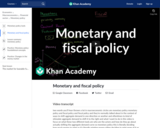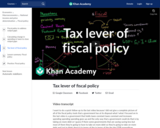
Basic mechanics of monetary and fiscal policy. Created by Sal Khan.
- Subject:
- Economics
- Social Science
- Material Type:
- Lesson
- Provider:
- Khan Academy
- Provider Set:
- Khan Academy
- Author:
- Sal Khan
- Date Added:
- 07/27/2021

Basic mechanics of monetary and fiscal policy. Created by Sal Khan.

Recognizing that a course in economics may seem daunting to some students, we have tried to make the writing clear and engaging. Clarity comes in part from the intuitive presentation style, but we have also integrated a number of pedagogical features that we believe make learning economic concepts and principles easier and more fun. These features are very student-focused. The chapters themselves are written using a “modular” format. In particular, chapters generally consist of three main content sections that break down a particular topic into manageable parts. Each content section contains not only an exposition of the material at hand but also learning objectives, summaries, examples, and problems. Each chapter is introduced with a story to motivate the material and each chapter ends with a wrap-up and additional problems. Our goal is to encourage active learning by including many examples and many problems of different types.

This course provides an overview of the following macroeconomic issues: the determination of output, employment, unemployment, interest rates, and inflation. Monetary and fiscal policies are discussed, as are public debt and international economic issues. This course also introduces basic models of macroeconomics and illustrates principles with the experience of the United States and other economies.

Principles of Macroeconomics 2e covers the scope and sequence of most introductory economics courses. The text includes many current examples, which are handled in a politically equitable way. The outcome is a balanced approach to the theory and application of economics concepts. The second edition has been thoroughly revised to increase clarity, update data and current event impacts, and incorporate the feedback from many reviewers and adopters.Changes made in Principles of Macroeconomics 2e are described in the preface and the transition guide to help instructors transition to the second edition.


By the end of this section, you will be able to:
Identify U.S. budget deficit and surplus trends over the past five decades
Explain the differences between the U.S. federal budget, and state and local budgets


By the end of this section, you will be able to:
Explain the nature and causes of unemployment
Analyze the natural rate of unemployment and the factors that affect it
Identify how undeveloped labor markets can result in the same hardships as unemployment



By the end of this section, you will be able to:Describe microeconomicsDescribe macroeconomicsContrast monetary policy and fiscal policy

Soar to Savings provides tips for saving and describes the impact of individual saving on the overall economy. As a result of this course, users will have a better understanding of opportunity cost, interest, down payments, and financial investment.

How government can effect aggregate demand through tax policy. Created by Sal Khan.

This is a complete course on Texas State government, developed by Austin Community College.


Fiscal Policy

Fiscal Policy